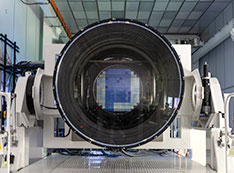A revolutionary 3.2 gigapixel camera mounted in a massive ground-based telescope will produce unprecedented views of the cosmos, driving discoveries with the widest, densest, and most complete images of our universe ever captured.
The Rubin Observatory Legacy Survey of Space and Time (LSST) will peer into space like no experiment has done before. LSST will be an unparalleled wide-field astronomical survey of our universe—wider and deeper in volume than all previous surveys combined.
The combination of a 3,200 megapixel camera sensor array, a powerful supercomputer, a sophisticated data processing and distribution network, and a massive telescope stationed on a mountaintop in Chile promises to cast light on mysteries fundamental to our understanding of the universe. From the distant signatures of dark energy to the dangers of near-earth asteroids, LSST will capture it all. Three central considerations dictated the design of LSST: that it be wide, fast, and deep.

WIDEA 3.5-degree field of view, more than 40 times the area of the full moon, will produce a complete survey of the entire night sky every three days, an impossible task for a smaller device.

FAST15-second exposures will chart the changes in space with 800 panoramic shots a night, tracking phenomena from the redshift at the edge of the universe to fast-moving asteroids closer to home.

DEEPThe sensitive camera array will ultimately image five billion galaxies, catching the subtle glow of the far-reaches of space in unprecedented detail.
LSST News
Brookhaven Builds the Digital Film
Brookhaven Lab led the development of the Rubin Observatory LSST camera’s “digital film,” a sensor array comprised of precise and sensitive electronics that capture images within the digital camera. The efficacy of LSST research hinges upon its massive resolution of 3.2 gigapixels—nearly 200 times larger than a high-end consumer camera.
Brookhaven’s Instrumentation Department led the development of novel charge-coupled device (CCD) sensors, alongside industry partners who took on the mass manufacturing. These unique CCDs are sensitive to light beyond the visible spectrum and have a much faster readout time than those in today’s most advanced astronomical cameras. Brookhaven scientists tackled the task of cramming 201 of these sensors into a camera that needs to be mounted on top of the telescope mirrors without obstructing the view. This effort required sophisticated thermo-mechanical design, a deep understanding of readout electronics, and a production line effort for the construction of 21 rafts with nine CCD sensors each. Together, these rafts act in concert to render a complete image for LSST and make up the largest CCD array that has ever been built.
Learn More
Brookhaven's Paul O'Connor with hardware developed for LSST. [Hi-res versions]
Illuminating the Dark
The known forms of matter and types of energy experienced here on Earth account for only four percent of the universe. The remaining 96 percent—though central to the history and future of the cosmos—remains shrouded in mystery. Two tremendous unknowns present one of the most tantalizing and essential questions in physics: What are dark energy and dark matter? LSST aims to expose both.
Dark Matter: Einstein deduced that massive objects in the universe bend the path of light passing nearby, proving the curvature of space. One way of observing the invisible presence of dark matter is examining the way its heavy mass bends the light from distant stars. This technique is known as gravitational lensing. The extreme sensitivity of the LSST camera, as well as its wide field of view, will help assemble comprehensive data on these cosmic lenses, offering clues to the presence of dark matter. The dense and mysterious substance acts as a kind of galactic glue, and it accounts for 25 percent of the universe.
Dark Energy: Something is driving the universe apart, accelerating the expansion begun by the Big Bang. This force accounts for 70 percent of the cosmos, yet is invisible and can only be “seen” by its effects on space. Because LSST is able to track cosmic movements over time, its images will provide some of the most precise measurements ever of our universe’s inflation. Light appears to stretch at the distant edges of space, a phenomenon known as redshift, and LSST may offer the key to understanding the cosmic anti-gravity behind it.
An Interactive Motion Picture
From its mountaintop site, the LSST camera will image the entire visible sky every few nights, capturing changes over time from seconds to years. Ultimately, after 10 years of observation, the LSST camera will enable scientists to create a stunning time-lapse movie of the universe.
As the Rubin Observatory stitches together thousands of images of billions of galaxies, it will process and upload that information for applications beyond pure research. Frequent and real time updates—100,000 a night—announcing the drift of a planet or the flicker of a dying star will be made available to both research institutions and interested astronomers.
In conjunction with platforms such as Google Earth, LSST will build a 3-D virtual map of the cosmos, allowing the public to fly through space from the comfort of home.
Get the latest updates and learn more at the Rubin Observatory website.

The Rubin Observatory site.








